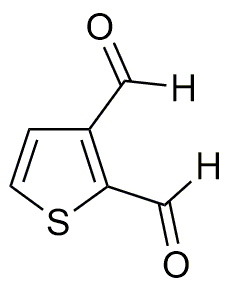2,3-Thiophenedicarboxaldehyde is widely utilized in research focused on:
- Organic Synthesis: This compound serves as a versatile building block in the synthesis of various organic molecules, including pharmaceuticals and agrochemicals, due to its reactive aldehyde groups.
- Material Science: It is used in the development of conductive polymers and materials, enhancing electrical properties which are crucial for applications in electronics and sensors.
- Fluorescent Dyes: The compound is employed in the production of fluorescent dyes, which are important in biological imaging and diagnostics, providing high sensitivity and specificity.
- Research in Catalysis: It plays a role in catalysis research, particularly in the development of new catalytic systems that can improve reaction efficiency and selectivity in chemical processes.
- Pharmaceutical Development: Researchers utilize it in drug discovery and development, particularly for designing compounds with potential therapeutic effects, owing to its unique chemical structure.
Informations générales
Propriétés
Sécurité et réglementation
Applications
2,3-Thiophenedicarboxaldehyde is widely utilized in research focused on:
- Organic Synthesis: This compound serves as a versatile building block in the synthesis of various organic molecules, including pharmaceuticals and agrochemicals, due to its reactive aldehyde groups.
- Material Science: It is used in the development of conductive polymers and materials, enhancing electrical properties which are crucial for applications in electronics and sensors.
- Fluorescent Dyes: The compound is employed in the production of fluorescent dyes, which are important in biological imaging and diagnostics, providing high sensitivity and specificity.
- Research in Catalysis: It plays a role in catalysis research, particularly in the development of new catalytic systems that can improve reaction efficiency and selectivity in chemical processes.
- Pharmaceutical Development: Researchers utilize it in drug discovery and development, particularly for designing compounds with potential therapeutic effects, owing to its unique chemical structure.
Documents
Fiches de données de sécurité (FDS)
La FDS fournit des informations de sécurité complètes sur la manipulation, le stockage et l’élimination du produit.
Spécifications du produit (PS)
Le PS fournit une description complète des propriétés du produit, notamment sa composition chimique, son état physique, sa pureté et les exigences de stockage. Il détaille également les plages de qualité acceptables et les applications prévues du produit.
Certificats d'analyse (COA)
Recherchez des certificats d'analyse (COA) en saisissant le numéro de lot du produit. Les numéros de lot et de lot se trouvent sur l'étiquette d'un produit, après les mots « Lot » ou « Lot de fabrication ».
Numéro de catalogue
Numéro de lot/série
Certificats d'origine (COO)
Ce certificat d'exploitation confirme le pays dans lequel le produit a été fabriqué, et détaille également les matériaux et composants utilisés et s'il est issu de sources naturelles, synthétiques ou autres sources spécifiques. Ce certificat peut être requis pour les douanes, le commerce et la conformité réglementaire.
Numéro de catalogue
Numéro de lot/série
Fiches de données de sécurité (FDS)
La FDS fournit des informations de sécurité complètes sur la manipulation, le stockage et l’élimination du produit.
DownloadSpécifications du produit (PS)
Le PS fournit une description complète des propriétés du produit, notamment sa composition chimique, son état physique, sa pureté et les exigences de stockage. Il détaille également les plages de qualité acceptables et les applications prévues du produit.
DownloadCertificats d'analyse (COA)
Recherchez des certificats d'analyse (COA) en saisissant le numéro de lot du produit. Les numéros de lot et de lot se trouvent sur l'étiquette d'un produit, après les mots « Lot » ou « Lot de fabrication ».
Numéro de catalogue
Numéro de lot/série
Certificats d'origine (COO)
Ce certificat d'exploitation confirme le pays dans lequel le produit a été fabriqué, et détaille également les matériaux et composants utilisés et s'il est issu de sources naturelles, synthétiques ou autres sources spécifiques. Ce certificat peut être requis pour les douanes, le commerce et la conformité réglementaire.


